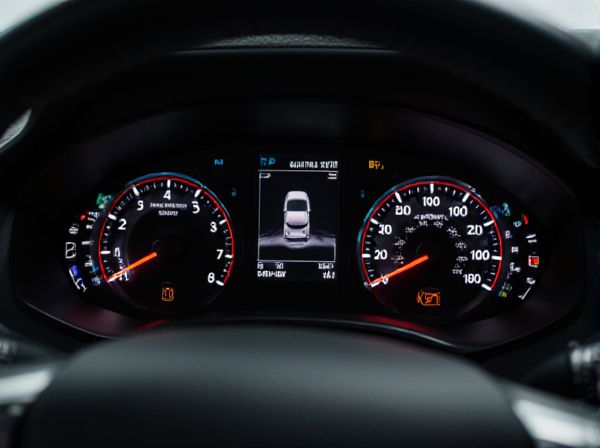
Photo illustration: Cluster Backlighting vs Pointer Illumination
Cluster backlighting enhances the visibility of your dashboard instruments by uniformly illuminating gauges and displays, ensuring clear readability in various lighting conditions. Pointer illumination specifically targets the pointers or needles on gauges, making it easier to quickly identify readings without distraction from other elements. Choosing between these lighting methods depends on whether you prioritize overall dashboard clarity or focused visibility on critical indicators.
Table of Comparison
| Feature | Cluster Backlighting | Pointer Illumination |
|---|---|---|
| Definition | Illumination of the entire dashboard cluster area. | Light focused specifically on the pointer or needle of gauges. |
| Purpose | Enhances overall visibility of speedometer, tachometer, and indicators. | Highlights exact gauge readings for quick, precise reading. |
| Energy Consumption | Moderate to high, due to broad lighting coverage. | Low energy usage, as it illuminates just the pointers. |
| Driver Focus | Improves general dashboard visibility and ambient illumination. | Directs focus to critical gauge data and improves reading accuracy. |
| Light Source | LED strips or panel backlighting behind the cluster. | Small LED bulbs or fiber optics targeting pointer tips. |
| Cost | Higher due to extensive lighting components. | Lower, simpler lighting elements involved. |
| Common Use | Standard in most modern car dashboards. | Often used in premium or sport vehicle dashboards. |
Introduction to Cluster Backlighting and Pointer Illumination
Cluster backlighting enhances instrument panel visibility by uniformly illuminating gauges and displays with LED or electroluminescent technology, improving readability in low-light conditions. Pointer illumination specifically highlights the indicator needles within clusters, using small, focused light sources to increase precision and reduce driver distraction. Both technologies optimize dashboard clarity but target different aspects of instrument visibility.
Key Differences Between Cluster Backlighting and Pointer Illumination
Cluster backlighting uniformly illuminates the entire instrument panel to enhance visibility of gauges and indicators under various lighting conditions, improving overall cockpit readability. Pointer illumination specifically targets the needle or pointer of a gauge, ensuring precise reading by highlighting its position against the dial face. The key difference lies in cluster backlighting's broad panel illumination versus pointer illumination's selective focus on needle visibility for accurate measurements.
Advantages of Cluster Backlighting
Cluster backlighting offers uniform illumination across the entire instrument panel, enhancing visibility and reducing eye strain during night driving. It allows for customizable brightness and color settings tailored to driver preferences, improving both safety and comfort. Improved readability of gauges and indicators with cluster backlighting ensures quicker information processing, contributing to safer vehicle operation.
Benefits of Pointer Illumination in Instrument Panels
Pointer illumination in instrument panels enhances visibility by providing direct, focused light on the gauge needle, improving readability in low-light conditions. This targeted lighting reduces eye strain and reaction time for drivers, leading to increased safety and comfort during night driving. Unlike cluster backlighting, pointer illumination highlights critical information precisely, aiding swift data interpretation.
Energy Efficiency Comparison
Cluster backlighting typically consumes more energy due to the need to uniformly illuminate a larger area such as an entire instrument panel, often relying on multiple LEDs or electroluminescent panels. Pointer illumination is more energy-efficient, as it focuses light on the needle or pointer only, reducing power consumption by limiting the illuminated surface area. Advanced LED technologies in pointer illumination systems further enhance energy efficiency by delivering targeted brightness with minimal electrical input.
Impact on Driver Visibility and Safety
Cluster backlighting enhances driver visibility by uniformly illuminating the instrument panel, allowing quick and clear reading of critical vehicle data under various lighting conditions. Pointer illumination specifically highlights gauge needles, improving precision in monitoring speed, RPM, and fuel levels, which is crucial for maintaining optimal driving performance and safety. Integrating both lighting methods reduces eye strain and distraction, contributing significantly to safer, more informed driving experiences.
Design Flexibility and Aesthetic Considerations
Cluster backlighting offers enhanced design flexibility by enabling uniform illumination across multiple indicators, allowing for customizable color schemes and brightness levels that can be tailored to specific brand aesthetics. Pointer illumination, on the other hand, emphasizes focused lighting on individual needles or pointers, promoting a sleek, minimalist look that enhances readability without distracting from the overall design. Both methods provide unique aesthetic advantages, with cluster backlighting being ideal for vibrant, complex displays and pointer illumination favoring simplicity and elegance in instrument panel design.
Cost Implications of Each Lighting Technology
Cluster backlighting involves the use of LED arrays or electroluminescent panels to evenly illuminate instrument panels, generally resulting in higher upfront costs due to hardware and installation complexity. Pointer illumination, utilizing targeted LED or fiber optic lights to highlight specific gauges or pointers, tends to have lower initial expenses but can incur increased maintenance costs over time due to replacement of individual light sources. Evaluating the total cost of ownership requires considering energy consumption, lifespan, and repair frequency, with cluster backlighting often providing better long-term value through uniform durability and efficiency.
Application Suitability: When to Choose Which
Cluster backlighting suits applications requiring uniform illumination of multiple indicators or displays, such as automotive instrument panels or control consoles, providing consistent visibility under varying lighting conditions. Pointer illumination is ideal for precise highlighting of specific dial pointers or indicators, enhancing readability in analog gauges where accurate reading of needle position is critical. Choose cluster backlighting for broad area visibility and pointer illumination for targeted, detail-oriented visibility in performance-critical settings.
Future Trends in Automotive Instrument Panel Lighting
Future trends in automotive instrument panel lighting emphasize advanced cluster backlighting techniques, leveraging OLED and micro-LED technologies for enhanced brightness, energy efficiency, and color customization. Pointer illumination is evolving with adaptive lighting systems that integrate sensors and AI to dynamically adjust visibility based on ambient conditions and driver preferences. The convergence of smart lighting controls and augmented reality will further transform instrument panel illumination, improving driver safety and interface intuitiveness.
 caratoz.com
caratoz.com